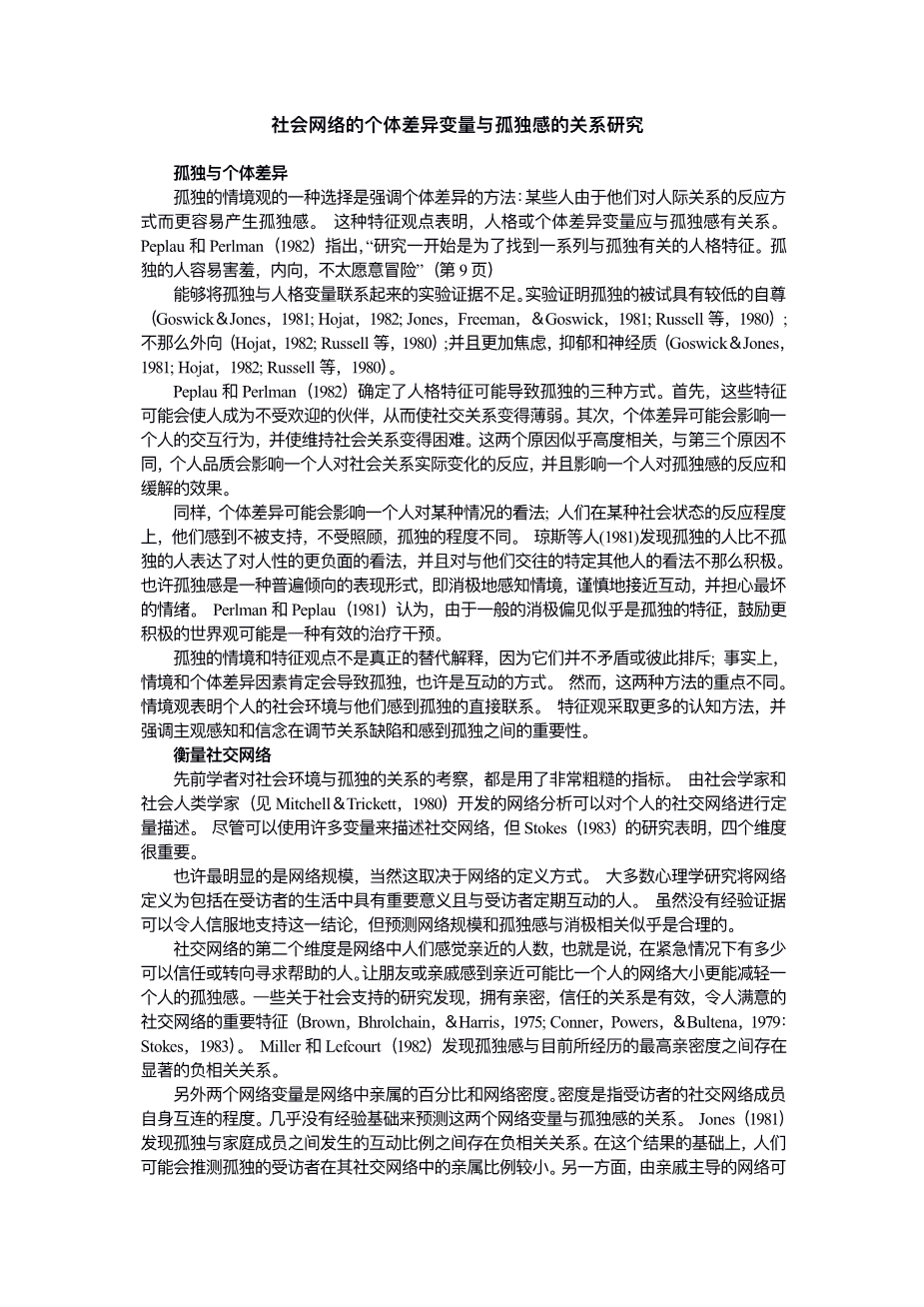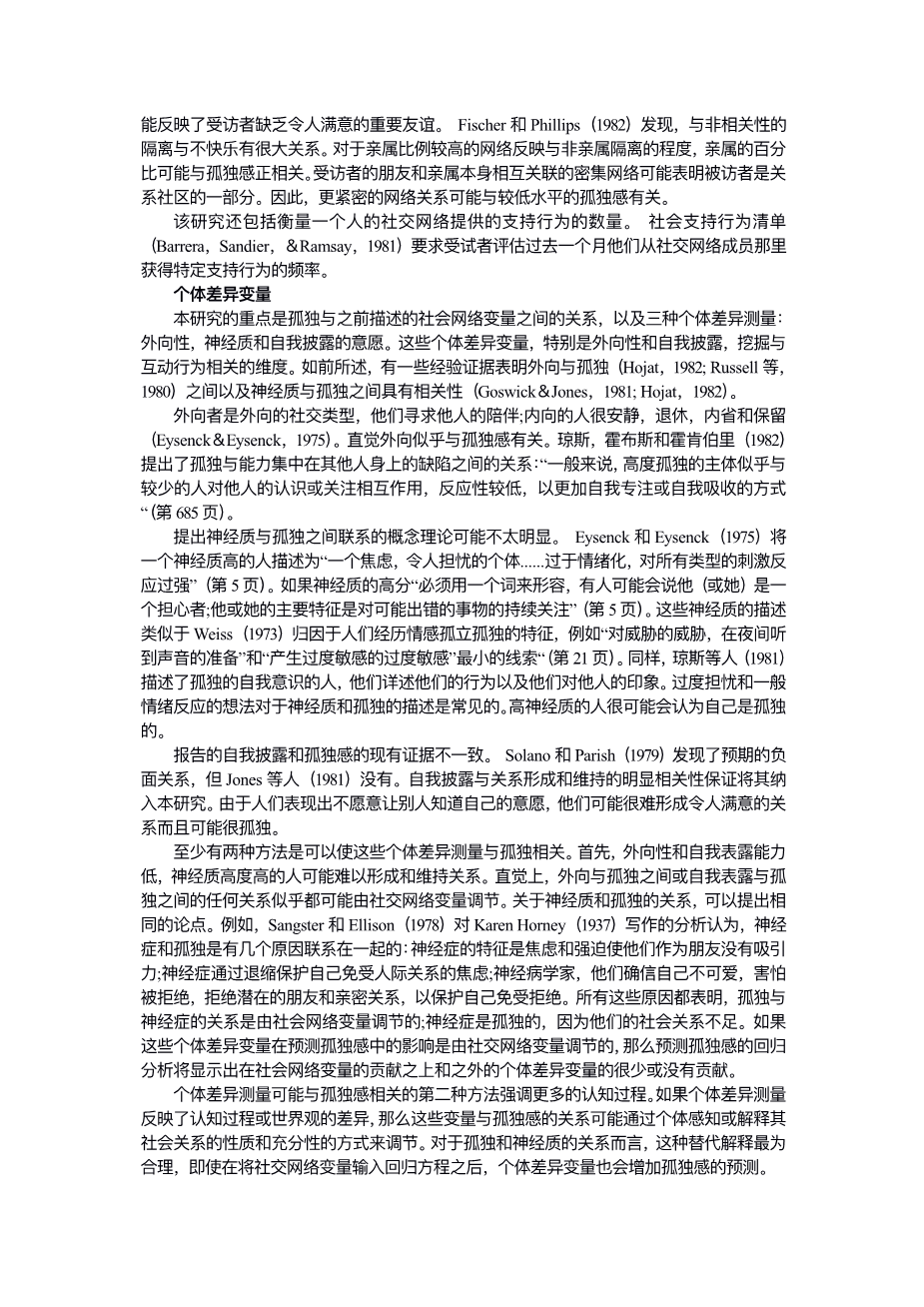The Relation of Social Network and Individual Difference
Variables to Loneliness
Loneliness and Individual Differences
An alternative to a situational view of loneliness is an approach that emphasizes individual differences: Certain people are prone to loneliness because of the way they react to interpersonal situations. This characterological view suggests that personality or individual difference variables should be associated with loneliness. Peplau and Perlman(1982) stated that "research is beginning to identify a set of personality characteristics that are consistently linked to loneliness. Lonely people are apt to be shy, introverted, and less willing to take social risks" (p. 9).
The scant experimental evidence that is available consistently links loneliness to personality variables. Lonely subjects have been shown to have lower self-esteem (Goswick amp;Jones, 1981; Hojat, 1982; Jones, Freeman, amp; Goswick, 1981; Russell et al., 1980); to be less extraverted (Hojat, 1982; Russell et al.,1980); and to be more anxious, depressed, and neurotic (Goswick amp; Jones, 1981; Hojat,1982; Russell et al., 1980).
Peplau and Perlman (1982) identified three ways in which personality characteristics might contribute to loneliness. First, the characteristics might make the person an undesirable companion and thereby reduce available social relationships. Second, individual differences might influence a person's interactional behavior and make maintaining relationships difficult. These two reasons seem highly related and different from the third, whereby personal qualities affect one's reaction to actual changes in social relations and influence how effective one is in reacting to and alleviating loneliness.
Similarly, individual differences may influence one's perception of a situation; people differ in the degree to which they feel unsupported, not cared for, and lonely in response to a given social state. Jones et al. (1981)found that lonely people expressed a more negative outlook on human nature and a less positive view of specific others with whom they interacted than did nonlonely people. Perhaps feelings of loneliness are one manifestation of a general tendency to perceive situations negatively, to approach interactions cautiously, and to fear the worst. Perlman amp;Peplau (1981) suggested that because a general negative bias seems characteristic of the lonely, encouraging a more positive world view might be an effective therapeutic intervention.
The situational and characterological views of loneliness are not really alternative explanations, because they are not contradictory or exclusive of one another; in fact, situational and individual difference factors surely each contribute to loneliness, perhaps in an inter-active way. The two approaches do, however, differ in emphasis. The situational view suggests a direct connection between the social environments of individuals and their feeling lonely. The characterological view takes amore cognitive approach and stresses the importance of subjective perceptions and beliefs in mediating between relational deficits and feeling lonely.
Measuring Social Networks
Previous attempts to examine the relation of social environment and loneliness have used very crude indications of the former. Network analysis, as developed by sociologists and social anthropologists (see Mitchell amp;Trickett, 1980), allows for quantitative descriptions of an individual's social network. Although a number of variables can be used to describe a social network, research by Stokes (1983) suggests four dimensions that are important.
Perhaps the most obvious is the size of the network, which of course depends on how the network is defined. Most psychological research defines the network to include people who are significant in the respondent's life and with whom the respondent interacts regularly. It seems reasonable to predict that network size and loneliness will be related negatively, although no empirical evidence convincingly supports this conclusion.
A second dimension of social networks is the number of people in the network one feels close to—that is, how many one can confide in or turn to for help in an emergency. Having friends or relative one feels close to is probably more important in alleviating loneliness than the size of one's network. Several studies of social support have found that having close, confiding relationships is an important feature of effective, satisfying social networks (Brown, Bhrolchain, amp; Harris,1975; Conner, Powers, amp; Bultena, 1979:Stokes, 1983). Miller and Lefcourt (1982)found a strong negative relation between loneliness and a measure of the maximum level of intimacy currently experienced.
Two other network variables are the percentage of relatives in the network and the density of the network. Density refers to the degree to which members of a respondent's social network are themselves interconnected. There is little empirical basis on which to predict the relation of these two network variables to loneliness. Jones (1981) found a negative relation between loneliness and the proportion of interactions that occurred with family members. On the basis of this result, one might speculate that lonely respondents would have a smaller percentage of relatives in their social networks. On the other hand, networks dominated by relatives might reflect a respondent's lack of satisfying, important friendships. Fischer and Phillips (1982) found that isolation from nonrelatives was substantially associated with not being happy. To the degree to which networks with a high percentage of relatives reflect isolation from non-relatives, percentage of relatives might be positively related to loneliness. Dense net-works, in which the respondents' friends and relatives are themselves interconnected,
剩余内容已隐藏,支付完成后下载完整资料


英语译文共 4 页,剩余内容已隐藏,支付完成后下载完整资料
资料编号:[423395],资料为PDF文档或Word文档,PDF文档可免费转换为Word


